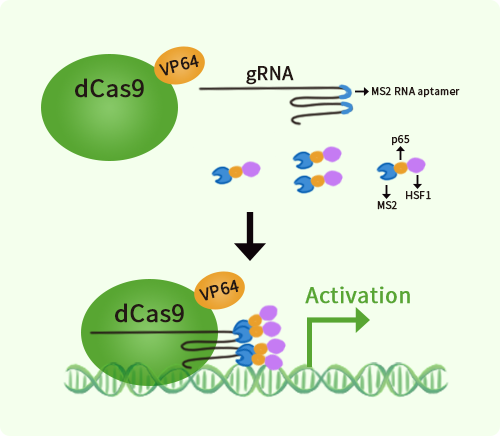Human GAPDH activation kit by CRISPRa
CAT#: GA101736
GAPDH CRISPRa kit - CRISPR gene activation of human glyceraldehyde-3-phosphate dehydrogenase
Find the corresponding CRISPRi Inhibitor Kit
USD 1,290.00
2 Weeks*
Specifications
| Product Data | |
| Format | 3gRNAs, 1 scramble ctrl and 1 enhancer vector |
| Symbol | GAPDH |
| Locus ID | 2597 |
| Kit Components | GA101736G1, GAPDH gRNA vector 1 in pCas-Guide-GFP-CRISPRa GA101736G2, GAPDH gRNA vector 2 in pCas-Guide-GFP-CRISPRa GA101736G3, GAPDH gRNA vector 3 in pCas-Guide-GFP-CRISPRa 1 CRISPRa-Enhancer vector, SKU GE100056 1 CRISPRa scramble vector, SKU GE100077 |
| Disclaimer | The kit is designed based on the best knowledge of CRISPa SAM technology. The efficiency of the activation can be affected by many factors, including nucleosome occupancy status, chromatin structure and the gene expression level of the target, etc. |
| Reference Data | |
| RefSeq | NM_001256799, NM_001289745, NM_001289746, NM_002046, NM_001357943, NR_152150 |
| Synonyms | G3PD; GAPD; HEL-S-162eP |
| Summary | 'This gene encodes a member of the glyceraldehyde-3-phosphate dehydrogenase protein family. The encoded protein has been identified as a moonlighting protein based on its ability to perform mechanistically distinct functions. The product of this gene catalyzes an important energy-yielding step in carbohydrate metabolism, the reversible oxidative phosphorylation of glyceraldehyde-3-phosphate in the presence of inorganic phosphate and nicotinamide adenine dinucleotide (NAD). The encoded protein has additionally been identified to have uracil DNA glycosylase activity in the nucleus. Also, this protein contains a peptide that has antimicrobial activity against E. coli, P. aeruginosa, and C. albicans. Studies of a similar protein in mouse have assigned a variety of additional functions including nitrosylation of nuclear proteins, the regulation of mRNA stability, and acting as a transferrin receptor on the cell surface of macrophage. Many pseudogenes similar to this locus are present in the human genome. Alternative splicing results in multiple transcript variants. [provided by RefSeq, Nov 2014]' |
Documents
| Product Manuals |
| FAQs |
Resources
Other Versions
| SKU | Description | Size | Price |
|---|---|---|---|
| KN202309 | GAPDH - human gene knockout kit via CRISPR, HDR mediated |
USD 1,290.00 |
|
| KN202309BN | GAPDH - human gene knockout kit via CRISPR, HDR mediated |
USD 1,290.00 |
|
| KN202309LP | GAPDH - human gene knockout kit via CRISPR, HDR mediated |
USD 1,290.00 |
|
| KN202309RB | GAPDH - human gene knockout kit via CRISPR, HDR mediated |
USD 1,290.00 |
|
| KN402309 | GAPDH - KN2.0, Human gene knockout kit via CRISPR, non-homology mediated. |
USD 1,290.00 |
{0} Product Review(s)
Be the first one to submit a review






























































































































































































































































 Germany
Germany
 Japan
Japan
 United Kingdom
United Kingdom
 China
China
